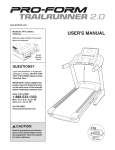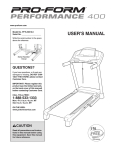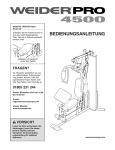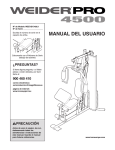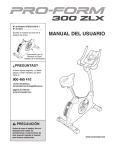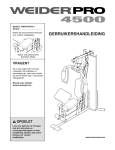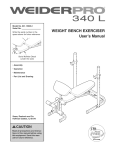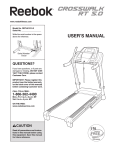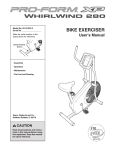Download ProForm 831.21752.0 User`s manual
Transcript
Model No. 831.21752.0 Serial No. Write the serial number in the space above for reference. Serial Number Decal • Assembly • Operation • Maintenance • Part List and Drawing Sears, Roebuck and Co. Hoffman Estates, IL 60179 CAUTION Read all precautions and instructions in this manual before using this equipment. Keep this manual for future reference. BIKE EXERCISER Userʼs Manual TABLE OF CONTENTS WARNING DECAL PLACEMENT . . . . . . . . . . . . . . . . . . . . . . . . . . . . . . . . . . . . . . . . . . . . . . . . . . . . . . . . . . . . . .2 IMPORTANT PRECAUTIONS . . . . . . . . . . . . . . . . . . . . . . . . . . . . . . . . . . . . . . . . . . . . . . . . . . . . . . . . . . . . . . . .3 BEFORE YOU BEGIN . . . . . . . . . . . . . . . . . . . . . . . . . . . . . . . . . . . . . . . . . . . . . . . . . . . . . . . . . . . . . . . . . . . . . .4 ASSEMBLY . . . . . . . . . . . . . . . . . . . . . . . . . . . . . . . . . . . . . . . . . . . . . . . . . . . . . . . . . . . . . . . . . . . . . . . . . . . . . . .5 HOW TO USE THE EXERCISE BIKE . . . . . . . . . . . . . . . . . . . . . . . . . . . . . . . . . . . . . . . . . . . . . . . . . . . . . . . . .13 MAINTENANCE AND TROUBLESHOOTING . . . . . . . . . . . . . . . . . . . . . . . . . . . . . . . . . . . . . . . . . . . . . . . . . . .19 EXERCISE GUIDELINES . . . . . . . . . . . . . . . . . . . . . . . . . . . . . . . . . . . . . . . . . . . . . . . . . . . . . . . . . . . . . . . . . . .20 PART LIST . . . . . . . . . . . . . . . . . . . . . . . . . . . . . . . . . . . . . . . . . . . . . . . . . . . . . . . . . . . . . . . . . . . . . . . . . . . . . .21 EXPLODED DRAWING . . . . . . . . . . . . . . . . . . . . . . . . . . . . . . . . . . . . . . . . . . . . . . . . . . . . . . . . . . . . . . . . . . . .22 ORDERING REPLACEMENT PARTS . . . . . . . . . . . . . . . . . . . . . . . . . . . . . . . . . . . . . . . . . . . . . . . . . .Back Cover 90 DAY FULL WARRANTY . . . . . . . . . . . . . . . . . . . . . . . . . . . . . . . . . . . . . . . . . . . . . . . . . . . . . . . . . .Back Cover WARNING DECAL PLACEMENT This drawing shows the location(s) of the warning decal(s). If a decal is missing or illegible, call 1-888-533-1333 and request a free replacement decal. Apply the decal in the location shown. Note: The decal(s) may not be shown at actual size. 2 IMPORTANT PRECAUTIONS WARNING: To reduce the risk of serious injury, read all important precautions and instructions in this manual and all warnings on your exercise bike before using your exercise bike. Sears assumes no responsibility for personal injury or property damage sustained by or through the use of this product. 9. Wear appropriate clothes while exercising; do not wear loose clothes that could become caught on the exercise bike. Always wear athletic shoes for foot protection. 1. Before beginning any exercise program, consult your physician. This is especially important for persons over age 35 or persons with pre-existing health problems. 10. The exercise bike should not be used by persons weighing more than 275 lbs. (125 kg). 2. Use the exercise bike only as described in this manual. 3. It is the responsibility of the owner to ensure that all users of the exercise bike are adequately informed of all precautions. 11. The pulse sensor is not a medical device. Various factors, including the user's movement, may affect the accuracy of heart rate readings. The pulse sensor is intended only as an exercise aid in determining heart rate trends in general. 4. The exercise bike is intended for home use only. Do not use the exercise bike in a commercial, rental, or institutional setting. 12. The exercise bike does not have a free wheel; the pedals will continue to move until the flywheel stops. Reduce your pedaling speed in a controlled way. 5. Keep the exercise bike indoors, away from moisture and dust. Do not put the exercise bike in a garage or covered patio, or near water. 13. Always keep your back straight while using the exercise bike; do not arch your back. 6. Place the exercise bike on a level surface with at least 2 ft. (0.6 m) of clearance around the exercise bike. To protect the floor or carpet from damage, place a mat under the exercise bike. 14. Over exercising may result in serious injury or death. If you feel faint or if you experience pain while exercising, stop immediately and cool down. 7. Inspect and properly tighten all parts regularly. Replace any worn parts immediately. 8. Keep children under age 12 and pets away from the exercise bike at all times. 3 BEFORE YOU BEGIN Thank you for selecting the PROFORM® XP 400 R exercise bike. Cycling is an effective exercise for increasing cardiovascular fitness, building endurance, and toning the body. The XP 400 R exercise bike provides an impressive selection of features designed to make your workouts at home more effective and enjoyable. after reading this manual, please see the back cover of this manual. To help us assist you, note the product model number and serial number before contacting us. The model number and the location of the serial number decal are shown on the front cover of this manual. Before reading further, please familiarize yourself with the parts that are labeled in the drawing below. For your benefit, read this manual carefully before you use the exercise bike. If you have questions Console Handlebar Water Bottle Holder* Backrest Seat Pedal/Strap Wheel Pulse Sensor Adjustment Handle *Water bottle is not included 4 ASSEMBLY Assembly requires two persons. Place all parts of the exercise bike in a cleared area and remove the packing materials. Do not dispose of the packing materials until assembly is completed. In addition to the included tool(s), assembly requires an adjustable wrench . screwdriver and a Phillips See the drawings below to identify the small parts needed for assembly. The number in parentheses below each drawing is the key number of the part, from the PART LIST near the end of this manual. The number following the key number is the quantity needed for assembly. Note: If a part is not in the hardware kit, check to see if it has been preassembled. To avoid damaging parts, do not use power tools for assembly. If a part is missing, call 1-888-533-1333. M4 x 16mm Screw (62)–10 M6 x 18mm Patch Screw (59)–2 M10 x 20mm Patch Screw (54)–4 M6 Washer (63)–4 M10 Split Washer (48)–2 M6 x 38mm Bolt (55)–4 M6 Locknut (56)–4 M6 x 42mm Patch Screw (60)–2 M10 x 36mm Screw (57)–2 M10 Locknut (58)–2 1/4" x 38mm Patch Screw (61)–4 M10 x 64mm Patch Screw (52)–3 M10 x 80mm Patch Screw (47)–2 5 1. 1 To make assembly easier, read the information on page 5 before you begin. With the help of another person, lift the Frame (1) and place a packing insert (not shown) under the Frame. Have the other person hold the Frame to prevent it from moving from side to side until you complete this step. 3 Attach the Front Stabilizer (3) to the Frame (1) with two M10 x 80mm Patch Screws (47) and two M10 Split Washers (48). 1 2. Attach the Rear Stabilizer (2) to the Frame (1) with three M10 x 64mm Patch Screws (52). 2 52 1 2 6 48 47 3. Identify the Right and Left Stabilizer Covers (12, 13), which are marked with “R” and “L” stickers. 3 Attach each Stabilizer Cover (12, 13) to the Rear Stabilizer (2) with two M4 x 16mm Screws (62). 62 62 13 2 62 12 62 4. Identify the Top Shield (14) and the Upright (4). 4 With the help of another person, slide the Top Shield (14) upward onto the Upright (4). Make sure that the Top Shield and the Upright are oriented as shown. Have the other person continue holding the Top Shield (14) in place while you complete step 5. 14 7 4 5. Tip: Avoid pinching the Wire Harness (40) during this step. 5 Have another person hold the Upright (4) and the Top Shield (14) near the Frame (1). Locate the wire tie in the Upright and the Wire Harness (40) in the Frame. Wire Tie 54 54 14 See the inset drawing. Tie the wire tie to one of the connectors on the Wire Harness (40). Then, pull the other end of the wire tie upward out of the top of the Upright (4). Discard the wire tie. 54 4 40 Wire Tie Slide the Upright (4) onto the Frame (1). Attach the Upright with four M10 x 20mm Patch Screws (54). Then, press the Top Shield (14) downward into the Frame. 6. Identify the Right and Left Handlebars (28, 29), which are marked with “R” and “L” stickers. 40 1 Avoid pinching the Wire Harness (40) 6 Attach each Handlebar (28, 29) to the Upright (4) with two M6 x 38mm Bolts (55) and two M6 Locknuts (56). Make sure that the hexagonal holes are in the indicated location. 4 29 Hexagonal Holes 8 55 56 28 7. The Console (5) can use four 1.5V D batteries (not included); alkaline batteries are recommended. IMPORTANT: If the Console has been exposed to cold temperatures, allow it to warm to room temperature before inserting batteries. Otherwise, you may damage the console displays or other electronic components. Remove the battery cover, insert the batteries into the battery compartments, and reattach the battery cover. Make sure to orient the batteries as shown by the diagram inside the battery compartments. 7 Battery Cover Batteries 5 Note: The battery cover may be attached with screws. To purchase an optional power adapter, call the telephone number on the cover of this manual. To avoid damaging the console, use only a manufacturer-supplied power adapter. Plug one end of the power adapter into the receptacle on the console; plug the other end into an outlet installed in accordance with all local codes and ordinances. 8. Tip: Avoid pinching the wires during this step. 8 While another person holds the Console (5) near the Upright (4), connect the console wires to the Wire Harness (40). Insert the excess wire downward into the Upright. Attach the Console (5) to the Upright (4) with four M4 x 16mm Screws (62). 5 Console Wires 9 4 40 Avoid pinching the wires 62 9. Tip: Avoid pinching the Pulse Wire (38) during this step. Orient the Pulse Bar (7) as shown. Attach the Pulse Bar to the Seat Carriage (6) with two M10 x 36mm Screws (57) and two M10 Locknuts (58). Do not tighten the Screws yet. 9 Avoid pinching the Pulse Wire (38) 7 38 58 6 57 57 10. Tip: Avoid pinching the Pulse Wire (not shown) during this step. Attach the Backrest (8) to the Seat Carriage (6) with two M6 x 18mm Patch Screws (59) and two M6 x 42mm Patch Screws (60). 10 59 8 See step 9. Tighten the M10 x 36mm Screws (57). 6 Avoid pinching the Pulse Wire (not shown) 10 60 11. Orient the Seat (9) as shown. Attach the Seat to the Seat Carriage (6) with four 1/4" x 38mm Patch Screws (61) and four M6 Washers (63). Note: The Patch Screws and the Washers may be preattached to the underside of the Seat. 11 9 6 63 61 12. Attach the Pulse Bar Cover (15) to the Seat Carriage (6) with two M4 x 16mm Screws (62). 61 12 15 62 11 6 13. Plug the Pulse Wire (38) into the Pulse Receptacle (39) in the Frame (1). 13 38 39 14. Identify the Right Pedal (44), which is marked with an “R.” Using an adjustable wrench, firmly tighten the Right Pedal clockwise into the right side of the Crank (17). 1 14 Tighten the Left Pedal (not shown) counterclockwise into the left side of the Crank. Adjust the strap on the Right Pedal (44) to the desired position, and press the ends of the straps onto the tabs on the Right Pedal. Adjust the strap on the Left Pedal (not shown) in the same way. 17 Strap 44 Tab 15. Make sure that all parts are properly tightened before you use the exercise bike. Note: After assembly is completed, some extra parts may be left over. Place a mat beneath the exercise bike to protect the floor. 12 HOW TO USE THE EXERCISE BIKE HOW TO ADJUST THE PEDAL STRAPS To adjust the pedal straps, first pull the ends of the straps off the tabs on the pedals. Adjust the straps to the desired position, and then press the ends of the straps onto the tabs. HOW TO MOVE THE EXERCISE BIKE To move the exercise bike, lift the rear stabilizer until the exercise bike can be moved on the front wheels. Carefully move the exercise bike to the desired location and then lower it to the floor. Pedal Strap Tab HOW TO ADJUST THE SEAT The seat can be adjusted forward or backward to the position that is the most comfortable for you. To adjust the seat, push downward on the adjustment handle, slide the seat to the desired position, and then pull upward on the adjustment handle to lock the seat in place. Wheel Seat Lift Here Adjustment Handle 13 CONSOLE DIAGRAM FEATURES OF THE CONSOLE The console also features the new iFit interactive workout system. The iFit interactive workout system enables the console to accept iFit cards containing workouts designed to help you achieve specific fitness goals. The advanced console offers an array of features designed to make your workouts more effective and enjoyable. When you select the manual mode of the console, you can change the resistance of the pedals with a touch of the dial. As you exercise, the console will provide continuous exercise feedback. You can even measure your heart rate using the handgrip pulse sensor. For example, lose unwanted pounds with the 8-week Weight Loss workout. iFit workouts control the resistance of the pedals while guiding you through your workouts. iFit cards are available separately. To purchase iFit cards, go to www.iFit.com or call the telephone number on the front cover of this manual. iFit cards are also available at select stores. The console also offers ten preset trainer workouts. Each workout automatically changes the resistance of the pedals and prompts you to increase or decrease your pedaling pace as it guides you through an effective workout. To use the manual mode, see page 15. To use a trainer workout, see page 16. To use a calorie goal workout, see page 17. To use an iFit workout, see page 18. To use the information mode, see page 18. In addition, there are four calorie goal workouts designed to help you burn 150, 175, 200, or 225 calories in a 30 minute workout. The calorie goal workouts automatically control the resistance of the pedals and prompt you to vary your pedaling pace while counting down the calories you burn. Note: If there is a sheet of plastic on the face of the console, remove the plastic. 14 HOW TO USE THE MANUAL MODE The third section of the display will show the approximate number of calories you have burned and the resistance level of the pedals. The display will change modes every few seconds. The display will also show your heart rate when you use the handgrip pulse sensor (see step 5 below). 1. Turn on the console. To turn on the console, press any button or begin pedaling. The display will light and the console will be ready for use. 2. Select the manual mode. Each time you turn on the console, the manual mode will be selected. If you have selected a workout, reselect the manual mode by pressing the Workout button repeatedly until zeroes appear in the display. The last section of the display will show a track representing 1/4 mile (400 meters). As you exercise, indicators will appear in succession around the track until the entire track appears. The track will then disappear and the indicators will again begin to appear in succession The console can show speed and distance in either miles or kilometers. The letters MPH or Km/H will appear in the display to indicate which unit of measurement is selected. To change the unit of measurement, see THE INFORMATION MODE on page 18. 3. Begin pedaling and change the resistance of the pedals as desired. As you pedal, change the resistance of the pedals by turning the Resistance dial. To increase the resistance, turn the Resistance dial clockwise; to decrease the resistance, turn the Resistance dial counterclockwise. Note: After you change the resistance, it will take a moment for the pedals to reach the selected resistance level. 5. Measure your heart rate if desired. If there are sheets of plastic on the metal contacts on Contacts the handgrip pulse sensor, remove the plastic. Next, hold the handgrip pulse sensor with your palms resting on the metal contacts. Avoid moving your hands or gripping the contacts too tightly. When your pulse is detected, a heartshaped symbol will flash in the display each time your heart beats and then your heart rate will be shown. For the most accurate heart rate reading, hold the contacts for at least 15 seconds. 4. Follow your progress with the display. The upper section of the display will show the elapsed time and the distance, in miles or kilometers, that you have pedaled. The display will change modes every few seconds. Note: When you select a workout, the display will show the time remaining in the workout instead of the elapsed time. 6. When you are finished exercising, the console will turn off automatically. The second section of the display will show your pedaling pace in miles or kilometers per hour. If the pedals do not move for a few seconds, the time will begin to flash in the display and the console will pause. If the pedals do not move for a few minutes and no buttons are pressed, the console will turn off and the display will be reset. 15 HOW TO USE A TRAINER WORKOUT As you exercise, the display will prompt you to keep your pedaling pace near the pace setting for the current segment. When the word “faster” appears in the display, increase your pace. When the word “slower” appears, decrease your pace. When the center of the target flashes, maintain your current pace. 1. Turn on the console. To turn on the console, press any button or begin pedaling. The display will light and the console will be ready for use. 2. Select a trainer workout. To select a trainer workout, press the Workout button repeatedly until the number of the desired workout appears in the display. The first section of the display will show the duration of the workout. A profile of the resistance levels for the workout will scroll across the last section of the display. Note: Complete profiles of the workouts are printed on the sides of the console. IMPORTANT: The pace settings are intended only to provide motivation. Your actual pace may be slower than the pace settings. Make sure to pedal at a pace that is comfortable for you. If the resistance level for the current segment is too high or too low, you can manually override the level by turning the Resistance dial. IMPORTANT: When the current segment of the workout ends, the pedals will automatically adjust to the resistance setting for the next segment. If you stop pedaling for several seconds, the console will pause and the time will begin to flash in the display. To restart the workout, press the Start button or simply resume pedaling. 3. Press the Start button or begin pedaling to start the workout. The workout will continue until the display shows a time of 0:00. Note: If you continue to pedal after the workout is completed, the display will continue to show exercise feedback; however, the display will not show the elapsed time until you select the manual mode or a new workout. Each workout is divided into 30 one-minute segments. One resistance level and one pace setting are programmed for each segment. Note: The same resistance level and/or pace setting may be programmed for consecutive segments. 4. Follow your progress with the display. During the workout, the workout profile will show your progress. The flashing segment of the profile represents the current segment of the workout. The height of the flashing segment indicates the resistance level for the current segment. At the end of each segment of the workout, a series of tones will sound and the next segment of the profile will begin to flash. If a different resistance level is programmed for the next segment, the resistance level will flash in the center display for a few seconds to alert you. The resistance of the pedals will then change. See step 4 on page 15. 5. Measure your heart rate if desired. See step 5 on page 15. 6. When you are finished exercising, the console will turn off automatically. See step 6 on page 15. 16 HOW TO USE A CALORIE GOAL WORKOUT As you exercise, the display will prompt you to keep your pedaling pace near the pace setting for the current segment. When the word “faster” appears in the display, increase your pace. When the word “slower” appears, decrease your pace. When the center of the target flashes, maintain your current pace. 1. Turn on the console. To turn on the console, press any button or begin pedaling. The display will light and the console will be ready for use. 2. Select a calorie goal workout. To select a calorie goal workout, press the Workout button repeatedly until the number of the desired workout appears in the display. The first section of the display will show the duration of the workout. The third section of the display will show the calorie goal for the workout. A profile of the resistance levels for the workout will scroll across the last section of the display. Note: Complete profiles of the workouts are printed on the sides of the console. IMPORTANT: The pace settings are intended only to provide motivation. Your actual pace may be slower than the pace settings. Make sure to pedal at a pace that is comfortable for you. If the resistance level for the current segment is too high or too low, you can manually override the level by turning the Resistance dial. IMPORTANT: When the current segment of the workout ends, the pedals will automatically adjust to the resistance setting for the next segment. If you stop pedaling for several seconds, the console will pause and the time will begin to flash in the display. To restart the workout, press the Start button or simply resume pedaling. 3. Press the Start button or begin pedaling to start the workout. The workout will continue until the display shows a time of 0:00. Note: If you continue to pedal after the workout is completed, the display will continue to show exercise feedback; however, the display will not show the elapsed time until you select the manual mode or a new workout. Each calorie goal workout will help you burn 150, 175, 200, or 225 calories. During each workout, the console will count down the number of calories to be burned. 4. Follow your progress with the display. Each workout is divided into 30 one-minute segments. One resistance level and one pace setting are programmed for each segment. Note: The same resistance level and/or pace setting may be programmed for consecutive segments. During a calorie goal workout, the third section of the display will show the number of calories to be burned during the remaining segments of the workout. During the workout, the workout profile will show your progress. The flashing segment of the profile represents the current segment of the workout. The height of the flashing segment indicates the resistance level for the current segment. At the end of each segment of the workout, a series of tones will sound and the next segment of the profile will begin to flash. If a different resistance level is programmed for the next segment, the resistance level will flash in the center display for a few seconds to alert you. The resistance of the pedals will then change. The other displays will show the information described in step 4 on page 15. 5. Measure your heart rate if desired. See step 5 on page 15. 6. When you are finished exercising, the console will turn off automatically. See step 6 on page 15. 17 HOW TO USE AN IFIT WORKOUT THE INFORMATION MODE 1. Press any button on the console or begin pedaling to turn on the console. The console features an information mode that allows you to select a unit of measurement for the console and to view usage information for the exercise bike. When you turn on the console, the display will light. A tone will then sound and the console will be ready for use. To select the information mode, press and hold down the Workout button for a few seconds. 2. Insert an iFit card and select a workout. The display will show the selected unit of measurement. An “E” for English miles or an “M” for metric kilometers will appear in the display. To change the unit of measurement, press the Start button repeatedly to select the desired unit of measurement. Note: When you replace the batteries, it may be necessary to reselect the unit of measurement. To use an iFit workout, insert an iFit card into the iFit slot; make sure that the iFit card is oriented so the metal contacts are face-down and are facing the slot. When the iFit card is properly inserted, the indicator next to the slot will light and words will appear in the display. iFit Slot iFit Card The display will also show the total distance pedaled since the exercise bike was purchased and the total number of hours the exercise bike has been used. The total distance pedaled will appear in the first section of the display. The total number of hours the exercise bike has been used will appear in the third section of the display. Next, select the desired workout on the iFit card by pressing the up and down buttons next to the iFit slot. Press the Start button or begin pedaling to start your workout. iFit workouts function in the same way as trainer workouts. To use the workout, see steps 3 to 5 on page 16. To exit the information mode, press the Workout button. 3. When you are finished exercising, remove the iFit card. Remove the iFit card when you are finished exercising. Store the iFit card in a secure place. 18 MAINTENANCE AND TROUBLESHOOTING Inspect and tighten all parts of the exercise bike regularly. To clean the exercise bike, use a damp cloth and a small amount of mild detergent; never use abrasives or solvents to clean the exercise bike. To avoid damaging the console, keep liquid away from the console. Slide the Reed Switch (24) slightly closer to or away from the Magnet (50), and then retighten the M4 x 16mm Screw (62). Turn the Crank (17) for a moment. Repeat these actions until the console displays correct feedback. When the reed switch is correctly adjusted, reattach the left shield and the left pedal. CONSOLE TROUBLESHOOTING HOW TO ADJUST THE BELT If the console display becomes dim, replace all the batteries at the same time; most console problems are the result of low batteries. See assembly step 7 on page 9 for replacement instructions. If you can feel the pedals slip while you are pedaling, even when the resistance is at the highest level, the belt may need to be adjusted. If the handgrip pulse sensor does not function properly, see step 5 on page 15. To adjust the belt, you must first remove the right pedal and the right shield. HOW TO ADJUST THE REED SWITCH Using an adjustable wrench, turn the right pedal counterclockwise and remove it. Next, remove the screws from the left and right shields. Then, gently remove the right shield. If the console does not display correct feedback, the reed switch should be adjusted. To adjust the reed switch, you must first remove the left pedal and the left shields. To tighten the belt, first loosen the M8 x 22mm Flat Head Screw (67). Next, tighten the M10 x 90mm Button Screw (69) until the Belt (18) is tight. Then, retighten the M8 x 22mm Flat Head Screw (67). Reattach the right shield and the right pedal. Using an adjustable wrench, turn the left pedal clockwise and remove it. Next, remove the screws from the left and right shields. Then, gently remove the left shield. Locate the Reed Switch (24). Turn the Crank (17) until a Magnet (50) is aligned with the Reed Switch. Next, loosen, but do not remove, the indicated M4 x 16mm Screw (62). 17 67 50 24 62 18 69 19 EXERCISE GUIDELINES WARNING: Burning Fat—To burn fat effectively, you must exercise at a low intensity level for a sustained period of time. During the first few minutes of exercise, your body uses carbohydrate calories for energy. Only after the first few minutes of exercise does your body begin to use stored fat calories for energy. If your goal is to burn fat, adjust the intensity of your exercise until your heart rate is near the lowest number in your training zone. For maximum fat burning, exercise with your heart rate near the middle number in your training zone. Before beginning this or any exercise program, consult your physician. This is especially important for persons over age 35 or persons with pre-existing health problems. The pulse sensor is not a medical device. Various factors may affect the accuracy of heart rate readings. The pulse sensor is intended only as an exercise aid in determining heart rate trends in general. Aerobic Exercise—If your goal is to strengthen your cardiovascular system, you must perform aerobic exercise, which is activity that requires large amounts of oxygen for prolonged periods of time. For aerobic exercise, adjust the intensity of your exercise until your heart rate is near the highest number in your training zone. These guidelines will help you to plan your exercise program. For detailed exercise information, obtain a reputable book or consult your physician. Remember, proper nutrition and adequate rest are essential for successful results. WORKOUT GUIDELINES EXERCISE INTENSITY Warming Up—Start with 5 to 10 minutes of stretching and light exercise. A warm-up increases your body temperature, heart rate, and circulation in preparation for exercise. Whether your goal is to burn fat or to strengthen your cardiovascular system, exercising at the proper intensity is the key to achieving results. You can use your heart rate as a guide to find the proper intensity level. The chart below shows recommended heart rates for fat burning and aerobic exercise. Training Zone Exercise—Exercise for 20 to 30 minutes with your heart rate in your training zone. (During the first few weeks of your exercise program, do not keep your heart rate in your training zone for longer than 20 minutes.) Breathe regularly and deeply as you exercise–never hold your breath. Cooling Down—Finish with 5 to 10 minutes of stretching. Stretching increases the flexibility of your muscles and helps to prevent post-exercise problems. EXERCISE FREQUENCY To find the proper intensity level, find your age at the bottom of the chart (ages are rounded off to the nearest ten years). The three numbers listed above your age define your “training zone.” The lowest number is the heart rate for fat burning, the middle number is the heart rate for maximum fat burning, and the highest number is the heart rate for aerobic exercise. To maintain or improve your condition, complete three workouts each week, with at least one day of rest between workouts. After a few months of regular exercise, you may complete up to five workouts each week, if desired. Remember, the key to success is to make exercise a regular and enjoyable part of your everyday life. 20 PART LIST Key No. Qty. 1 2 3 4 5 6 7 8 9 10 11 12 13 14 15 16 17 18 19 20 21 22 23 24 25 26 27 28 29 30 31 32 33 34 35 36 37 38 39 40 1 1 1 1 1 1 1 1 1 1 1 1 1 1 1 1 1 1 1 1 1 1 1 1 1 1 1 1 1 2 2 2 2 4 2 4 4 1 1 1 Description Key No. Qty. Frame Rear Stabilizer Front Stabilizer Upright Console Seat Carriage Pulse Bar Backrest Seat Right Shield Left Shield Right Stabilizer Cover Left Stabilizer Cover Top Shield Pulse Bar Cover Eddy Mechanism Pulley/Crank Belt Idler Resistance Motor Crank Bearing Assembly Flywheel Axle Clamp Reed Switch Wire Adjustment Handle Seat Lock Seat Lock Bracket Right Handlebar Left Handlebar Handlebar Cap Seat Carriage Cap Upper Roller Lower Roller Roller Axle Pulse Grip Pulse Sensor Pulse Contact Pulse Wire Pulse Receptacle/Wire Wire Harness 41 42 43 44 45 46 47 48 49 50 51 52 53 54 55 56 57 58 59 60 61 62 63 64 65 66 67 68 69 70 71 72 73 * * * * * * 2 2 2 1 1 2 2 2 1 2 1 3 4 4 4 4 2 3 2 2 4 24 14 8 1 2 1 1 1 2 1 10 1 – – – – – – Model No. 831.21752.0 R1110A Description Wheel Stabilizer Cap Bumper Right Pedal/Strap Left Pedal/Strap M10 x 41mm Shoulder Screw M10 x 80mm Patch Screw M10 Split Washer M4 x 16mm Bright Screw Magnet Resistance Cable M10 x 64mm Patch Screw M3.8 x 20mm Screw M10 x 20mm Patch Screw M6 x 38mm Bolt M6 Locknut M10 x 36mm Screw M10 Locknut M6 x 18mm Patch Screw M6 x 42mm Patch Screw 1/4" x 38mm Patch Screw M4 x 16mm Screw M6 Washer 1/4" x 16mm Button Screw M10 Washer M5 x 14mm Screw M8 x 22mm Flat Head Screw M8 Locknut M10 x 90mm Button Screw 1/4" x 14mm Screw M8 Washer M6 Split Washer M4 x 22mm Screw Assembly Tool 15 1/2" Zip Tie 8" Zip Tie Panel Fastener Grommet Userʼs Manual Note: Specifications are subject to change without notice. For information about ordering replacement parts, see the back cover of this manual. If a part is missing, call 1-888-533-1333. *These parts are not illustrated. 21 22 72 64 72 62 57 64 57 7 35 36 37 63 63 53 64 58 63 61 33 32 34 34 64 6 58 63 63 63 9 72 72 64 64 31 63 53 72 27 63 35 37 36 70 72 26 8 38 29 60 59 25 40 59 60 30 56 15 5 39 55 54 4 14 54 56 54 30 62 54 28 55 EXPLODED DRAWING A Model No. 831.21752.0 R1110A 62 23 42 62 13 62 62 45 52 62 43 11 73 42 2 62 45 51 16 58 65 62 12 62 62 43 66 22 49 20 21 1 62 18 68 71 69 46 67 23 17 19 50 21 24 41 50 62 3 62 62 41 48 62 10 46 44 44 47 EXPLODED DRAWING B Model No. 831.21752.0 R1110A Get it fixed, at your home or ours! Your Home For repair—in your home—of all major brand appliances, lawn and garden equipment, or heating and cooling systems, no matter who made it, no matter who sold it! For the replacement parts, accessories, and user’s manuals that you need to do-it-yourself. For Sears professional installation of home appliances and items like garage door openers and water heaters. 1-800-4-MY-HOME® (1-800-469-4663) Call anytime, day or night (U.S.A. and Canada) www.sears.com www.sears.ca Our Home For repair of carry-in items like vacuums, lawn equipment, and electronics, call or go on-line for the location of your nearest Sears Parts & Repair Center. 1-800-488-1222 Call anytime, day or night (U.S.A. only) www.sears.com To purchase a protection agreement (U.S.A.) or maintenance agreement (Canada) on a product serviced by Sears: 1-800-827-6655 (U.S.A.) 1-800-361-6665 (Canada) Para pedir servicio de reparación a domicilio, y para ordenar piezas: 1-888-SU-HOGAR® (1-888-784-6427) ® Registered Trademark / TM Trademark / SM Service Mark of Sears Brands, LLC ® Marca Registrada / TM Marca de Fábrica / SM Marca de Servicio de Sears Brands, LLC 90 DAY FULL WARRANTY If this Sears bike exerciser fails due to a defect in material or workmanship within 90 days of the date of purchase, call 1-800-4-MY-HOME® (1-800-469-4663) to arrange for free repair (or replacement if repair proves impossible). The frame is warranted for a period of 7 years from the date of purchase. This warranty does not apply when the bike exerciser is used commercially or for rental purposes. This warranty gives you specific legal rights, and you may also have other rights which vary from state to state. Sears, Roebuck and Co., Hoffman Estates, IL 60179 Part No. 264264 R1110A Printed in China © 2010 ICON IP, Inc.

























